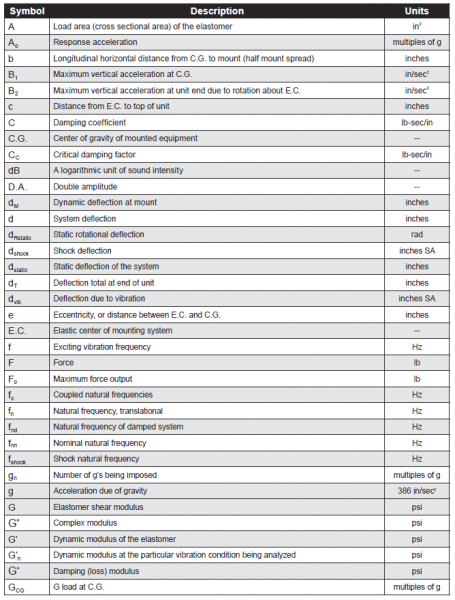LORD Corporation
With more than 3,100 employees in 26 countries, 19 manufacturing facilities and 10 R&D centers worldwide, we're there for our customers.
Our Company
-
Products and Solutions
To speak to someone directly, call
Customer Support:
8AM–5PM EST
Technical Support:
8AM–5PM EST
-
Industries
To speak to someone directly, call
Customer Support:
8AM–5PM EST
Technical Support:
8AM–5PM EST
-
Our Company
To speak to someone directly, call
Customer Support:
8AM–5PM EST
Technical Support:
8AM–5PM EST
-
Feedback Button
Feedback Button
Questionnaire
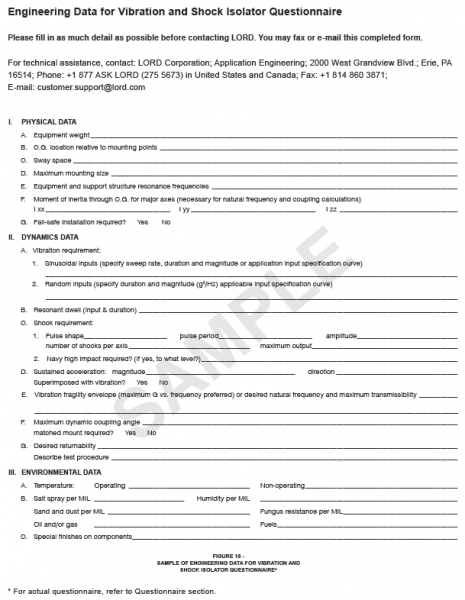 Specification of Isolator Selection Factors — This page includes a Questionnaire, or “Data Required” form, which is helpful in the definition and analysis of the considerations and factors listed below. If the indicated information is available, the selection of an isolator will be greatly enhanced. The theory that follows in a further section is academic if the information to apply it is not available.
Specification of Isolator Selection Factors — This page includes a Questionnaire, or “Data Required” form, which is helpful in the definition and analysis of the considerations and factors listed below. If the indicated information is available, the selection of an isolator will be greatly enhanced. The theory that follows in a further section is academic if the information to apply it is not available.
Considerations in Selecting a Vibration Isolator
In the process of deciding on a vibration isolator for a particular application, there are a number of critical pieces of information which are necessary to define the desired functionality of the isolator. Some items are more critical than others, but all should be considered in order to select or design the appropriate product.
Some of the factors which must be considered are:
Weight, Size, Center-of-Gravity of the Equipment to be Isolated — The weight of the unit will have a direct bearing on the type and size of the isolator. The size or shape of the equipment can also affect the isolator design since this may dictate the type of attachment and the available space for the isolator. The center-of-gravity location is also important as isolators of different load capacities may be necessary at different points on the equipment due to weight distribution. The locations of the isolators relative to the center-of-gravity — at the base of the equipment versus in the plane of the C.G., for example — could also affect the design of the isolator.
Types of Dynamic Disturbances to be Isolated — This is basic to the definition of the problem to be addressed by the isolator selection process. In order to make an educated selection or design of a vibration/shock isolator, this type of information must be defined as well as possible. Typically, sinusoidal and/or random vibration spectra will be defined for the application. In many installations of military electronics equipment, random vibration tests have become commonplace and primary military specifications for the testing of this type of equipment (such as MIL-STD-810) have placed heavy emphasis on random vibration, tailored to the actual application. Other equipment installations, such as in shipping containers, may require significant amounts of sinusoidal vibration testing.
Shock tests are often required by many types of equipment. Such tests are meant to simulate those operational (e.g., carrier landing of aircraft) or handling (e.g., bench handling or drop) conditions which lead to impact loading of the equipment.
Static Loadings Other than Supported Weight — In addition to the weight and dynamic loadings which isolators must react, there are some static loads which can impact the selection of the isolator. An example of such loading is the load imposed by an aircraft in a high-speed turn. This maneuver loading must be reacted by the isolator and can, if severe enough, necessitate an increase in the isolator size. These loads are often superposed on the dynamic loads.
Allowable System Response — This is another basic piece of information. In order to appropriately isolate a piece of equipment, the response side of the problem must be known. The equipment manufacturer or user should have some knowledge of the fragility of the unit. This fragility, related to the specified dynamic loadings will allow the selection of an appropriate isolator. This may be expressed in terms of the vibration level versus frequency or the maximum shock loading which the equipment can endure without malfunctioning or breaking. If the equipment manufacturer or installer is experienced with vibration/shock isolation, this allowable response may be specified as the allowable natural frequency and maximum transmissibility allowed during a particular test.
The specification of allowable system response should include the maximum allowable motion of the isolated equipment. This is important to the selection of an isolator since it may define some mechanical motion limiting feature which must be incorporated into the isolator design. It is fairly common to have an incompatibility between the allowable “sway space” and the motion necessary for the isolator to perform the desired function. In order to isolate to a certain degree, it is required that a definite amount of motion be allowed. Problems in this area typically arise when isolators are not considered early enough in the process of designing the equipment or the structural location of the equipment.
Ambient Environment — The environment in which the equipment is to be used is very important to the selection of an isolator. Within the topic of environment, temperature is by far the most critical item. Variations in temperature can cause variations in the performance of many typical vibration/shock isolators. Thus, it is quite important to know the temperatures to which the system will be exposed. The majority of common isolators are elastomeric. Elastomers tend to stiffen and gain damping at low temperatures and to soften and lose damping at elevated temperatures. The amount of change depends on the type of elastomer selected for a particular installation.
Other Environmental Effects — Effects from humidity, ozone, atmospheric pressure, altitude, etc. are minimal and may typically be ignored. Some external factors that may not be thought of as environmental may impact on the selection of an isolator. Fluids (oils, fuels, coolants, etc.) which may come in contact with the isolators can cause a change in the material selection or the addition of some form of protection for the isolators. The level of fluid exposure (immersion vs. splash) is a determining factor.
Service Life — The length of time for which an isolator is expected to function effectively is another strong determining factor in the selection or design process. Vibration isolators, like other engineering structures, have finite lives. Those lives depend on the loads imposed on them. The prediction of the life of a vibration/shock isolator depends on the distribution of loads over the typical operating spectrum of the equipment being isolated. Typically, the longer the desired life of the isolator, the larger that isolator must be for a given set of operating parameters. The definition of the isolator operating conditions is important to any reliable prediction of life.
Theory
The solutions to most isolator problems begin with consideration of the mounted system as a damped, single degree of freedom system. This allows simple calculations of most of the parameters necessary to decide if a standard isolator will perform satisfactorily or if a custom design is required.
This approach is based on the facts that:
- Many isolation systems involve center-of-gravity installations of the equipment. That is, the center-of-gravity of the equipment coincides with the elastic center of the isolation system. The center-of-gravity installation is often recommended since it allows performance to be predicted more accurately and it allows the isolators to be loaded in an optimum manner. Figure 1 shows some typical center-of-gravity systems.
- Many equipment isolation systems are required to be isoelastic. That is, the system translational spring rates in all directions are the same.
- Many pieces of equipment are relatively light in weight and support structures are relatively rigid in comparison to the stiffness of the isolators used to support and protect the equipment.
For cases which do not fit the above conditions, or where more precise analysis is required, there are computer programs available to assist the analyst.
LORD computer programs for dynamic analysis are used to determine the system response to various dynamic disturbances. The loads, motions and accelerations at various points on the isolated equipment may be found and support structure stiffnesses may be taken into account. Some of the more sophisticated programs may even accept and analyze non-linear systems. This discussion is reason to emphasize the need for the information regarding the intended application of the isolated equipment. The dynamic environment, the ambient environment and the physical characteristics of the system are all important to a proper analysis. The use of the checklist included with this catalog is recommended as an aid.
With the above background in mind, the aim of this theory section will be to use the single degree-of-freedom basis for the initial selection of standard isolators. This is the first step toward the design of custom isolators and the more complex analyses of critical applications.
Single Degree-of-Freedom Dynamic System
Figure 2 shows the “classical” mass-spring-damper depiction of a single degree-of-freedom dynamic system. Figure 3 and the related equations show this system as either damped or undamped. Figure 4 shows the resulting vibration response transmissibility curves for the damped and undamped systems of Figure 3.
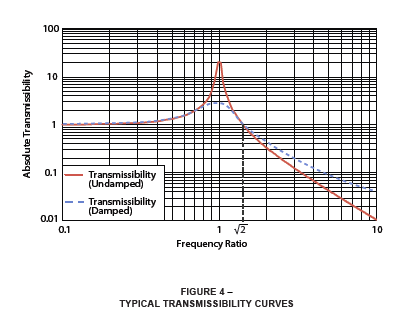
These figures and equations are well known and serve as a useful basis for beginning the analysis of an isolation problem. However, classical vibration theory is based on one assumption that requires understanding in the application of the theory. That assumption is that the properties of the elements of the system behave in a linear, constant manner. Data to be presented later will give an indication of the factors which must be considered when applying the analysis to the real world.
The equations of motion for the model systems in Figure 3 are familiar to many. For review purposes, they are presented here.
For the undamped system, the differential equation of motion is:

In which it may be seen that the forces due to the dynamic input (which varies as a function of time) are balanced by the inertial force of the accelerating mass and the spring force. From the solution of this equation, comes the equation defining the natural frequency of an undamped spring-mass system:

Another equation which is derived from the solution of the basic equation of motion for the undamped vibratory system is that for transmissibility – the amount of vibration transmitted to the isolated equipment through the mounting system depending on the characteristics of the system and the vibration environment.

Wherein, “r” is the ratio of the exciting vibration frequency to the system natural frequency. That is:

In a similar fashion, the damped system may be analyzed. The equation of motion here must take into account the damper which is added to the system. It is:

The equation for the natural frequency of this system may, for normal amounts of damping, be considered the same as the undamped system. That is,

In reality, the natural frequency does vary slightly with the amount of damping in the system. The damping factor is given the symbol “ζ” and is approximately one-half the loss factor, “η”, described in the definition section regarding damping in elastomers. The equation for the natural frequency of a damped system, as related to that for an undamped system, is:

The damping ratio, ζ, is defined as:

Where, the “critical” damping level for a damped vibratory system is defined as:

The equation for the absolute transmissibility of a damped system is written as:

The equations for the transmissibilities of the undamped and damped systems are plotted in Figure 4. As may be seen, the addition of damping reduces the amount of transmitted vibration in the amplification zone, around the natural frequency of the system (r = 1). It must also be noted that the addition of damping reduces the amount of protection in the isolation region (where r > √2).
In the real world of practical isolation systems, the elements are not linear and the actual system response does not follow the above analysis rigorously. Typically, elastomeric isolators are chosen for most isolation schemes. Elastomers are sensitive to the vibration level, frequency and temperature to which they are exposed. The following discussion will present real world modifications to the above theory, provide guidance in the application of isolators for typical installations, and detail the sensitivities of different elastomers.
Modifications to Theory Based on the Real World
It should be apparent from the preceding discussion that the basic assumption of linearity in dynamic systems must be modified when dealing with elastomeric vibration isolators. These modifications do affect the results of the analysis of an isolated system and should be taken into account when writing specifications for vibration isolators. It should also be noted that similar effects of variation with vibration level have been detected with “metal mesh” isolators.
Thus, care must be exercised in applying them. The amount of variability of these isolators is somewhat different than with elastomeric isolators and depends on too many factors to allow simple statements to be made.
The following discussion will be based on the properties of elastomeric isolators.
Static Stiffness versus Shock Stiffness versus Vibration Stiffness — Because of the strain and frequency sensitivity of elastomers, elastomeric vibration and shock isolators perform quite differently under static, shock or vibration conditions.
The equation:

Where:
dstatic = static deflection of the system (in)
fn = system natural frequency (Hz)
DOES NOT HOLD for elastomeric vibration/shock isolators. The static stiffness is typically less than the dynamic stiffness for these materials. To say this another way, the static deflection will be higher than expected if it were calculated, using the above formula, based on a vibration or shock test of the system.
Similarly, neither the static nor the vibration stiffness of such devices is applicable to the condition of shock disturbances of the system. It has been found empirically that:

The difference in stiffness between vibration and static conditions depends on the strain imposed by the vibration on the elastomer. Figure 5 shows where the static modulus will lie in relation to the dynamic modulus for some typical elastomers at various strain levels.
What this means to the packaging engineer or dynamicist is that one, single stiffness value cannot be applied to all conditions and that the dynamic to static stiffness relationship is dependent on the particular isolator being considered. What this means to the isolator designer is that each condition of use must be separately analyzed with the correct isolator stiffness for each condition.
Shock Considerations — As stated in the previous discussion, shock analyses for systems using elastomeric isolators should be based on the guideline that the isolator stiffness will be approximately 1.4 times the static stiffness. In addition to this, it must be remembered that there must be enough free deflection in the system to allow the shock energy to be stored in the isolators.
If the system should bottom, the “g” level transmitted to the mounted equipment will be much higher than would be calculated. In short, the system must be allowed to oscillate freely once it has been exposed to a shock disturbance to allow theory to be applied appropriately. Figure 9 shows this situation schematically.
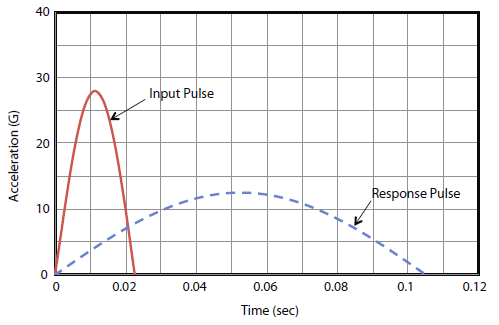
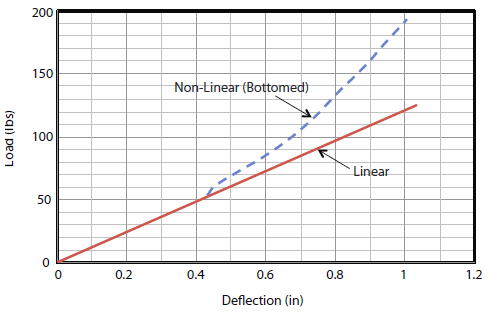
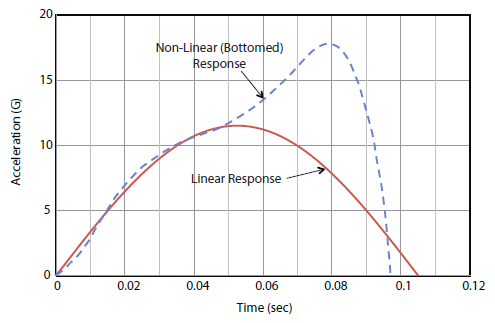
FIGURE 9
In considering the above, several items should be noted:
• Damping in the system will dissipate some of the input energy and the peak transmitted shock will be slightly less than predicted based on a linear, undamped system.
• “Ʈ” is the shock input pulse duration (seconds).
• “tn” is one-half of the natural period of the system (seconds).
• There must be enough free deflection allowed in the system to store the energy without bottoming (snubbing). If this is not considered, the transmitted shock may be significantly higher than calculated and damage may occur in the mounted equipment.
Vibration Considerations — The performance of typical elastomeric isolators changes with changes in dynamic input – the level of vibration to which the system is being subjected. This is definitely not what most textbooks on vibration would imply. The strain sensitivity of the elastomers causes the dynamic characteristics to change.
Figure 10 is representative of a model of a vibratory system proposed by Professor Snowdon of Penn State University in his book, “Vibration and Shock in Damped Mechanical Systems.” This model recognized the changing properties of elastomers and the effects of these changes on the typical vibration response of an isolated system. These effects are depicted in the comparison of a theoretically calculated transmissibility response curve to one resulting from a test of an actual system using elastomeric isolators.
The Real World
The majority of vibration and shock isolators are those utilizing elastomeric elements as the source of compliance and damping to control system responses.
G* is “Complex Modulus” (see Figure 10)

Where:
η = loss factor

Where:
G" = damping modulus (psi)
G' = dynamic modulus (psi)
ζ = damping factor (dimensionless)
Using this model, we may express the absolute transmissibility of the system as:

Where:
G'n = dynamic modulus (psi) at the particular vibration condition being analyzed
The resulting transmissibility curve from such a treatment, compared to the classical, theoretical transmissibility curve, is shown in Figure 11.
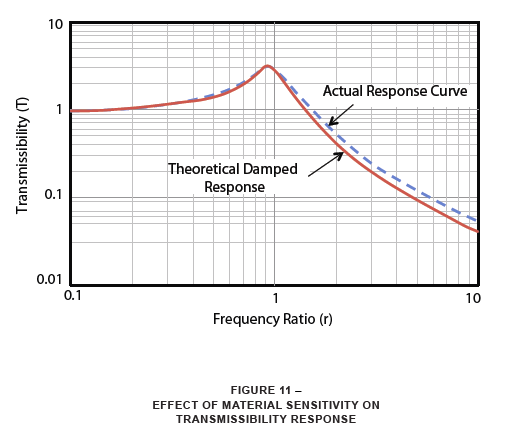
Two important conclusions may be reached on the basis of this comparison:
- The “crossover” point of the transmissibility curve (TABS = 1.0) occurs at a frequency higher than 2 times the natural frequency which is what would be expected based on classical vibration theory. This crossover frequency will vary depending on the type of vibration input and the temperature at which the test is being conducted.
- The degree of isolation realized at high frequencies (TABS < 1.0) will be less than calculated for an equivalent level of damping in a classical analysis. This slower “roll-off” rate "dB/octave" will also depend on the type of elastomer, level and type of input and temperature.
In general, a constant amplitude sinusoidal vibration input will have less effect on the transmissibility curve than a constant ‘g’ (acceleration) vibration input. The reason is that, with increasing frequency, the strain across the elastomer is decreasing more rapidly with the constant ‘g’ input than with a constant amplitude input. Remembering the fact that decreasing strain causes increasing stiffness in elastomeric isolators, this means that the crossover frequency will be higher and the roll-off rate will be lower for a constant ‘g’ input than for a constant amplitude input. Figure 12 is representative of these two types of vibration inputs as they might appear in a test specification.
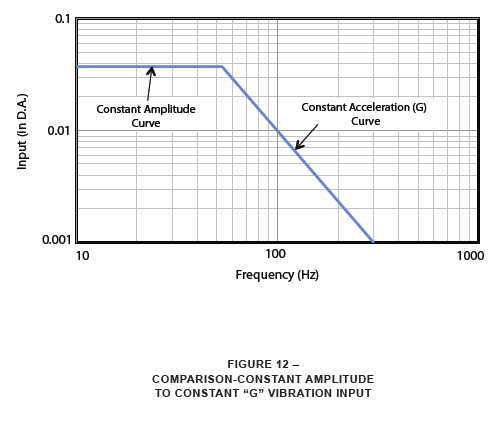
No general statement of where the effects of random vibration will lead in relationship to a sinusoidal constant ‘g’ or constant amplitude vibration input can be made. However, the effects will be similar to a sinusoidal vibration since random vibrations typically produce lower strains across isolators as frequency increases. There may be some exceptions to this statement. In the section, Determining Necessary Characteristics of Vibration/Shock Isolator, guidance is provided as how to apply the properties of elastomers to the various conditions which may be specified for a typical installation requiring isolators.
Data Required to Select or Design a Vibration/Shock Isolator — As with any engineering activity, the selection or design of an isolator is only as good as the information on which that selection or design is based. Figure 13 is an example of one available LORD checklist for isolator applications (click on image for actual questionnaire).
Click for Actual Questionnaire
If the information on this checklist is provided, the selection of an appropriate isolator can be aided greatly, both in timeliness and suitability.
Checklist Section I provides the information about the equipment to be mounted (its size, weight and inertias) and the available space for the isolation system to do its job. This latter item includes isolator size and available sway space for equipment movement.
Checklist Section II tells the designer what the dynamic disturbances are and how much of those disturbances the equipment can withstand. The difference is the function of the isolation system.
It is important to note here that the random vibration must be provided as a power spectral density versus frequency tabulation or graph, not as an overall “gRMS” level, in order to allow analysis of this condition. Also, note that the U.S. Navy “high impact” shock test is required by specification MIL-S-901 for shipboard equipment.
Checklist Section III contains space for descriptions of any special environmental exposures which the isolators must withstand. Also, for critical applications, such as gyros, optics and radar isolators, the requirements for control of angular motion of the isolated equipment are requested. In such cases, particular effort should be made to keep the elastic center of the isolation system and the center-of-gravity of the equipment at the same point. The vibration isolators may have their dynamic properties closely matched in order to avoid the introduction of angular errors due to the isolation system itself.
All of the information listed on the checklist shown in Figure 13 is important to the selection of a proper vibration isolator for a given application. As much of the information as possible should be supplied as early as possible in the design or development stage of your equipment. Of course, any drawings or sketches of the equipment and the installation should also be made available to the vibration/shock analyst who is selecting or designing isolators.
Determining Necessary Characteristics of a Vibration/Shock Isolator
The fragility of the equipment to be isolated is typically the determining factor in the selection or design of an isolator. The critical fragility level may occur under vibration conditions or shock conditions. Given one of these starting points, the designer can then determine the dynamic properties required of isolators for the application. Then, knowing the isolator required, the designer may estimate the remaining dynamic and static performance properties of the isolator and the mounted system.
The following sections will present a method for analyzing the requirements for an isolation problem and for selecting an appropriate isolator.
Sinusoidal Vibration Fragility as the Starting Point — A system specification, equipment operation requirements or a known equipment fragility spectrum may dictate what the system natural frequency must, or may, be. Figure 14 shows a fictitious fragility curve superimposed on a typical vibration input curve. Isolation system requirements may be derived from this information.
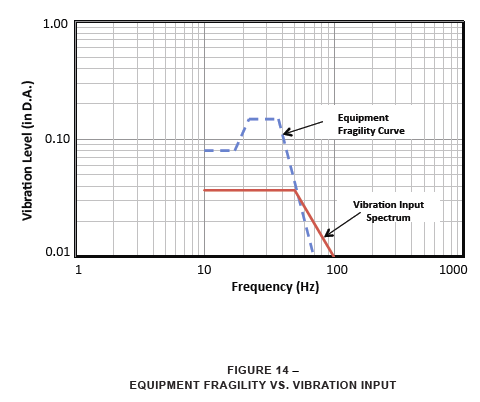
First, the allowable transmissibility at any frequency may be calculated as the ratio of the allowable output to the specified input.

The frequency at which this ratio is a maximum is one frequency at which the system natural frequency may be placed (assuming that it is greater than approximately 2.5, at some frequency). Another method of placing the system natural frequency is to select that frequency which will allow the isolation of the input over the required frequency range. A good rule of thumb is to select a frequency which is at least a factor of 2.0 below that frequency where the allowable response (output) crosses over – goes below – the specified input curve.
Having determined an acceptable system natural frequency, the system stiffness (spring rate) may be calculated from the following relationship:

Where:
K' = total system dynamic stiffness (lb/in) at the specified vibration input
fn = selected system natural frequency (Hz)
W = isolated equipment weight (lb)
An individual isolator spring rate may then be determined by dividing this system spring rate by the allowable, or desired number of isolators to be used. The appropriate isolator may then be selected based on the following factors:
• required dynamic spring rate
• specified vibration input at the desired natural frequency of the system
• static load supported per isolator
• allowable system transmissibility
• environmental conditions (temperature, fluid exposure, etc.)
Once a particular isolator has been selected, the properties of the elastomer in the isolator may be used to estimate the performance of the isolator at other conditions of use, such as other vibration levels, shock inputs, steady state acceleration loading and temperature extremes. The necessary elastomer property data are found in Figures 5, 6, 7 and 8.
If the vibration input in the region of the required natural frequency is specified as a constant acceleration – constant ‘g’ – it may be converted to a motion input through the equation:

Where:
Xi = vibratory motion (inches, double amplitude)
gi = specified vibratory acceleration input (g)
fn = desired system natural frequency (Hz)
Of course, this equation may be used to convert constant acceleration levels to motions at any frequency. It is necessary to know this vibratory motion input in order to select or design an isolator. Note, that most catalog vibration isolators are rated for some maximum vibration input level expressed in inches double amplitude. Also, the listed dynamic stiffnesses for many standard isolators are given forspecific vibration inputs. This information provides a starting point on Figure 5 to allow calculation of the system performance at vibration levels other than that listed for the isolator.
Random Vibration Performance as the Starting Point — Random vibration is replacing sinusoidal vibration in specifications for much of today’s equipment. A good example is MIL-STD-810. Many of the vibration levels in the most recent version of this specification are given in the now familiar format of “power spectral density” plots. Such specifications are the latest attempt to simulate the actual conditions facing sensitive equipment in various installations. A combination of theory and experience is used in the analysis of random vibration. As noted previously, the random input must be specified in the units of “g2/Hz” in order to be analyzed and to allow proper isolator selection. The system natural frequency may be determined by a fragility versus input plot of random vibration just as was done and demonstrated in Figure 14 for sinusoidal vibration. Once the required natural frequency is known, the necessary isolator spring rate may again be calculated from the equation:

The next steps in determining which isolator may be used are to calculate the allowable transmissibility and the motion at which the isolated system responds at the same natural frequency as when it is subjected to the specified random vibration. The allowable transmissibility, if not already specified, may be calculated from the input vibration and the allowable vibration by using the equation:

Where:
TR = resonant transmissibility (dimensionless)
SO = output random vibration (g2/Hz)
Si = input random vibration (g2/Hz)
A sinusoidal vibration input, acceleration or motion, at which the system will respond at approximately the same natural frequency with the specified random vibration may be calculated in the following manner.
Step 1: The analysis of random vibration is made on the basis of probability theory. The one sigma (1σ) root mean square (RMS) acceleration response may be calculated from the equation:

goRMS = 1 RMS acceleration response (g)
Si = input random vibration (g2/Hz)
TR = allowable resonant transmissibility
fn = desired natural frequency (Hz)
Step 2: It has been found empirically that elastomeric isolators typically respond at a 3σ vibration level. Thus, the acceleration vibration level at which the system will respond at approximately the same natural frequency as with the specified random level may be found to be:

Step 3: The above is response acceleration. To find the input for this condition of response, we simply divide by the resonant transmissibility.

Step 4: Finally, we apply the equation from a previous section to calculate the motion input vibration equivalent to this acceleration at the system natural frequency:

Note that Xi is in units of inches double amplitude.
Step 5: The analysis can now follow the scheme of previous calculations to find the appropriate isolator and then analyze the shock, static and temperature performance of the isolator.
Shock Fragility as the Starting Point — If the fragility of the equipment in a shock environment is the critical requirement of the application, the natural frequency of the system will depend on the required isolation of the shock input.
Step 1: Calculate the necessary shock transmissibility:

Where:
Ts = shock transmissibility (dimensionless)
Go = equipment fragility (g)
Gi = input shock level (g)
Step 2: Calculate the required shock natural frequency. This depends on the shape of the shock pulse.
The following approximate equations may be used only for values of Ts < 1.0:

Where:
Ts = shock transmissibility
fn = shock natural frequency (Hz)
Ʈ = shock pulse length (seconds)
Remember, that the system natural frequency under a shock condition will typically be different from that under a vibration condition for systems using elastomeric vibration isolators.
Step 3: Calculate the required deflection to allow this level of shock protection by the equation:

Where:
dshock = shock deflection (inches single amplitude)
Go = shock response or equipment fragility (g)
fn = shock natural frequency (Hz)
Step 4: Calculate the required dynamic spring rate necessary under the specified shock condition from the equation:

Where:
K' = dynamic stiffness (lb/in)
fn = shock natural frequency (Hz)
W = supported weight (lb)
Step 5: Select the proper isolator from those available in the product section, that is, one which has the required dynamic stiffness (K'), will support the specified load and will allow the calculated deflection (dShock) without bottoming during the shock event.
Step 6: Determine the dynamic stiffness (K') of the chosen isolator, at the vibration levels specified for the application, by applying Figure 5 with the knowledge that dynamic spring rate is directly proportional to dynamic modulus (G') and by working from a known dynamic stiffness of the isolator at a known dynamic motion input.
Step 7: Calculate system natural frequencies under specified vibration inputs from the equation:

Where:
fn = vibration natural frequency (Hz)
K' = isolator dynamic stiffness at the specified vibration level (lb/in)
W = supported weight (lb)
Note that the stiffness and supported weight must be considered on the same terms, i.e., if the stiffness is for a single mount, then the supported weight must be that supported on one mount. Once the system natural frequency is calculated, the system should be analyzed to determine what effect this resonance will have on the operation and/or protection of the equipment.
Step 8: Estimate the static stiffness of the isolators from the relationship:

Where:
K = static stiffness (lb/in)
K'shock = shock dynamic stiffness (lb/in)
Then, check the deflection of the system under the 1g load and under any steady-state (maneuver) loads from the equation:

Where:
dstatic = static deflection (inches)
gn = number of g’s loading being imposed
W = supported load (lb)
K = static spring rate (lb/in)
Be sure that the chosen isolator has enough deflection capability to accommodate the calculated motions without bottoming. If the vibration isolation function and steady state accelerations must be imposed on the system simultaneously, the total deflection capability of the isolator must be adequate to allow the deflections from these two sources combined. Thus,
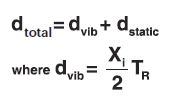
Where:
Xi = input vibration motion at resonance (inches double amplitude)
dvib = deflection due to vibration (inches single amplitude)
TR = resonant transmissibility
dstatic = static deflection per the above equation (inches)
Types of Isolators and Their Properties — There are a number of different types of isolators, based on configuration, that may be applied in supporting and protecting various kinds of equipment. Depending on the severity of the application and on the level of protection required for the equipment, one or another of these mounting types may be applied. Figures 15, 16 and 17 show some of the most common “generic” configurations of vibration isolators and the characteristic load versus deflection curves for the simple shear mounting and the “buckling column” types of isolators. In general, the fully bonded or holder types of isolators are used for more critical equipment installations because these have superior performance characteristics as compared to the center bonded or unbonded configurations. The buckling column type of isolator is useful in applications where high levels of shock must be reduced in order to protect the mounted equipment. Many aerospace equipment isolators are of the conical type because they are isoelastic.
Figure 15 - Typical Mounting Types and Buckling Column Rolling Section Type

In order of preference for repeatability of performance, the rank of the various isolator types is:
- Fully Bonded
- Holder Type
- Center Bonded
- Unbonded
In reviewing the standard lines of LORD isolators, the Low Profile Avionics (AM Series), Pedestal (PS Series), Plate Form (100 & 150 Series), Multiplane (106 & 156 Series), High Deflection (HDM & MHDM Series), Miniature (MAA Series) and Micro-Mounts (MX Series) are in the fully bonded category. The BTR (HT Series) mounts are the only series in the holder type category. The Miniature MCB Series of isolators is the offering in the center bonded type of mount. The Miniature MGN/MGS Series mounts are in the unbonded mount category. In total, these standard offerings from LORD cover a wide range of stiffnesses and load ratings to satisfy the requirements of many vibration and shock isolation applications.
In some instances, there may be a need to match the dynamic stiffness and damping characteristics of the isolators which are to be used on any particular piece of equipment. Some typical applications of matched sets of isolators are gyros, radars and optics equipment. For these applications, the fully bonded type of isolator construction is highly recommended. The dynamic performance of these mounts is much more consistent than other types. Dynamically matched isolators are supplied in sets but are not standard since matching requirements are rarely the same for any two applications.
Estimating Isolator Size
There will be occasions when custom designs will be required for vibration and shock isolators. It should be remembered that schedule and economy are in favor of the use of the standard isolators shown in the product section. These products should be used wherever possible. Where these will not suffice, LORD will assist by providing the design of a special mount. The guidelines presented here are to allow the packaging or equipment engineer to estimate the size of the isolator so that the equipment installation can be made with the thought in mind to allow space for the isolators and for the necessary deflection of the system as supported on them. The final isolator size may be slightly larger or smaller depending on the specifications being imposed.
Figure 21 shows a schematic of a conical isolator, such as may be used for protection of avionic equipment. The two most important parameters in estimating the size of such an isolator are the length of the elastomer wall, tR, and the available load area. For purposes of simplification, a conical angle of 45° is used here. The ratio of axial to radial stiffness depends on this angle.
The elastomer wall length may be estimated based on the dynamic motion necessary for the requirements of the application. This length may be estimated through the following equation:

Where:
tR = elastomer wall length (inches)
Xi = resonant vibration input (inches double amplitude)
TR = resonant transmissibility
From the required natural frequency, the necessary dynamic spring rate is known from:

Where:
K' = dynamic stiffness (lb/in)
fn = desired natural frequency (Hz)
W = supported weight per isolator (lb)
For a conical type isolator, the dynamic spring rate/geometry relationship is:

Where:
K'S = dynamic stiffness (lb/in)
G' = dynamic modulus of the elastomer (psi)
tR = elastomer wall length (inches)
A (area term) is estimated as:

This area term should be determined such that the dynamic stress at resonance is kept below approximately 40 psi.
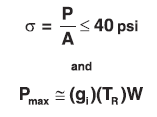
Where:
σ = dynamic stress (lb/in2)
P = applied force (lb)
A = load area of the elastomer (in2)
gi = input ‘g’ level at resonance
TR = resonant transmissibility
W = supported load per isolator (lb)
The combination of the elastomer wall length (tR) and load area (A), estimated from the above, and the required attachment features will provide a good estimate of the size of the isolator required to perform the necessary isolation functions. The proper dynamic modulus is then selected for the isolator from an available range of approximately 90 to 250 psi at a 0.036 inch D.A., vibration input.
Resonant Dwells
The requirement of a “resonant dwell” of isolated equipment is becoming less common in today’s world. However, some projects still have such a requirement and it may be noted that many of the products described in the product section have been exposed to resonant dwell conditions and have performed very well. Isolators designed to the elastomer wall and load area guidelines given above will survive resonant dwell tests without significant damage for systems with natural frequencies below approximately 65 Hz. Systems higher in natural frequency than this require special consideration and LORD engineers should be consulted.
Environmental Resistance
Many of the isolators shown in this catalog are inherently resistant to most of the environments (temperature, sand, dust, fungus, ozone, etc.) required by many specifications. The silicone elastomers are all in this category. One particularly critical area is fluid resistance where special oils, fuels or hydraulic fluids could possibly come in contact with the elastomer. LORD engineering should be contacted for an appropriate elastomer selection.
Testing of Vibration/Shock Isolators
LORD has excellent facilities for the testing of isolators. Electrodynamic shakers having up to eight thousand pound dynamic force capability are used to test many of the isolators designed or selected for customer use. These shakers are capable of sinusoidal and random vibration testing as well as sine-on-random and random-on-random conditions. These machines are also capable of many combinations of shock conditions and are supplemented with free-fall drop test machines. Numerous isolator qualification tests have been performed within the test facilities at LORD.
Further Theory
The preceding discussion presented general theory, and modifications to theory based on the real world, which are applicable to a broad class of vibration and shock problems. A special class of shock analysis is that which involves drop tests, or specifications, such as with protective shipping containers. Click here for more on this special section.
Elastomers for Vibration and Shock Isolation
Depending on the ambient conditions and loads, a number of elastomers may be chosen for the isolators in a given isolation system. As seen in the above discussion, the addition of damping allows more control of the system in the region of resonance. The compromise which is made here though is that isolation is sacrificed. The higher the amount of damping, the greater the compromise. In addition, typical highly damped elastomers exhibit poor returnability and greater drift than elastomers which have medium or low damping levels. The requirements of a given application must be carefully weighed in order to select the appropriate elastomer.
Within the various families of LORD products, a number of elastomers may be selected. Some brief descriptions may help to guide in their selection for a particular problem.
Natural Rubber — This elastomer is the baseline for comparison of most others. It was the first elastomer and has some desirable properties, but also has some limitations in many applications. Natural rubber has high strength, when compared to most synthetic elastomers. It has excellent fatigue properties and low to medium damping which translates into efficient vibration isolation. Typically, natural rubber is not very sensitive to vibration amplitude (strain). On the limitation side, natural rubber is restricted to a fairly narrow temperature range for its applications. Although it remains flexible at relatively low temperatures, it does stiffen significantly at temperatures below 0°F (-18°C). At the high temperature end, natural rubber is often restricted to use below approximately 180°F (82°C).
Neoprene — This elastomer was originally developed as a synthetic replacement for natural rubber and has nearly the same application range. Neoprene has more sensitivity to strain and temperature than comparable natural rubber compounds.
SPE® I — This is another synthetic elastomer which has been specially compounded by LORD for use in applications requiring strength near that of natural rubber, good low temperature flexibility and medium damping. The major use of SPE I elastomer has been in vibration and shock mounts for the shipping container industry. This material has good retention of flexibility to temperatures as low as -65°F (-54°C). The high temperature limit for SPE I elastomer is typically +165°F (+74°C).
BTR® — This elastomer is LORD Corporation’s original “Broad Temperature Range” elastomer. It is a silicone elastomer which was developed to have high damping and a wide span of operational temperatures. This material has an application range from -65°F to +300°F (-54°C to +149°C). The loss factor of this material is in the range of 0.32. This elastomer has been widely used in isolators for Military Electronics equipment for many years. It does not have the high load carrying capability of natural rubber but is in the high range for materials with this broad temperature range.
BTR® II — This material is similar in use to the BTR elastomer except that it has a slightly more limited temperature range and has less damping. BTR II may be used for most applications over a temperature range from -40°F to +300°F (-40°C to +149°C). The loss factor for typical BTR II compounds is in the range of 0.18. This elastomer has better returnability, less drift and better stability with temperature, down to -40°F (-40°C). The compromise with BTR II elastomer is the lower damping. This means that the resonant transmissibility of a system using BTR II elastomeric isolators will be higher than one using BTR isolators. At the same time, the high frequency isolation will be slightly better with the BTR II. This material has found use in Military Electronics isolators as well as in isolation systems for aircraft engines and shipboard equipment.
BTR® VI — This is a very highly damped elastomer. It is a silicone elastomer of the same family as the BTR elastomer but is specially compounded to have loss factors in the 0.60 to 0.70 range. This would result in resonant transmissibility readings below 2.0 if used in a typical isolation system. This material is not used very often in applications requiring vibration isolation. It is most often used in products which are specifically designed for damping, such as lead-lag dampers for helicopter rotors. If used for a vibration isolator, BTR VI will provide excellent control of resonance but will not provide the degree of high frequency isolation that other elastomers will provide. The compromises here are that this material is quite strain and temperature sensitive, when compared to BTR and other typical Miltronics elastomers, and that it tends to have higher drift than the other materials.
“MEM” — This is an elastomer which has slightly less damping than LORD Corporation’s BTR silicone, but which also has less temperature and strain sensitivity. The typical loss factor for the MEM series of silicones is 0.29, which translates into a typical resonant transmissibility of 3.6 at room temperature and moderate strain across the elastomer. This material was developed by LORD at a time when some electronic guidance systems began to require improved performance stability of isolation systems across a broad temperature range, down to -70°F (-57°C), while maintaining a reasonable level of damping to control resonant response.
“MEA” — With miniaturization of electronic instrumentation, equipment became slightly more rugged and could withstand somewhat higher levels of vibration, but still required more constant isolator performance over a wide temperature range. These industry trends led to the development of LORD MEA silicone. As may be seen in the material property graphs of Figures 5 through 8, this elastomer family offers significant improvement in strain and temperature sensitivity over the BTR and MEM series. The compromise with the MEA silicone material is that it has less damping than the previous series. This results in typical loss factors in the range of 0.23 - resonant transmissibility of approximately 5.0. The MEA silicone also shows less drift than the standard BTR series elastomer.
“MEE” — This is another specialty silicone elastomer which was part of the development of materials for low temperature service. It has excellent consistency over a very broad temperature range – even better than the MEA material described above. The compromise with this elastomer is its low damping level. The typical loss factor for MEE is approximately 0.11, which results in resonant transmissibility in the range of 9.0. The low damping does give this material the desirable feature of providing excellent high frequency isolation characteristics along with its outstanding temperature stability.
With the above background, some of the properties of these elastomers, as they apply to the application of LORD isolators, will be presented. As with metals, elastomers have measurable modulus properties. The stiffness and damping characteristics of isolators are directly proportional to these moduli and vary as the moduli vary.
Strain, Temperature and Frequency Effects — The engineering properties of elastomers vary with strain (the amount of deformation due to dynamic disturbance), temperature and the frequency of the dynamic disturbance. Of these three effects, frequency typically is the least and, for most isolator applications, can normally be neglected. Strain and temperature effects must be considered.
Strain Sensitivity — The general trend of dynamic modulus with strain is that modulus decreases with increasing strain. This same trend is true of the damping modulus. The ratio of the damping modulus to dynamic elastic modulus is approximately equal to the loss factor for the elastomer. The inverse of this ratio may be equated to the expected resonant transmissibility for the elastomer. This may be expressed as:

Where:
G' = dynamic modulus (psi)
G" = damping (loss) modulus (psi)
η= loss factor
TR = resonant transmissibility
more exactly:

In general, resonant transmissibility varies only slightly with strain while the dynamic stiffness of an isolator may, depending on the elastomer, vary quite markedly with strain.

Figure 5 presents curves which depict the variation of the dynamic modulus of various elastomers which may be used in vibration isolators as related to the dynamic strain across the elastomer. These curves may be used to approximate the change in dynamic stiffness of an isolator due to the dynamic strain across the elastomer. This is based on the fact that the dynamic stiffness of an isolator is directly proportional to the dynamic modulus of the elastomer used in it. This relationship may be written as:

Where:
K'S = dynamic shear stiffness (lb/in)
G' = dynamic shear modulus of the elastomer (psi)
tR = elastomer thickness (in)
A = load area of the elastomer (in2)
This variation may be used to calculate the change in a dynamic system’s natural frequency from the equation:

Where:
fn = system natural frequency (Hz)
K' = total system dynamic spring rate (lb/in)
W = total weight supported by the isolators (lb)
As there is a change in dynamic modulus, there is a variation in damping due to the effects of strain in elastomeric materials. One indication of the amount of damping in a system is the resonant transmissibility of that system. Figure 6 shows the variation in resonant transmissibility due to changes in vibration input for the elastomers typically used in LORD military electronics isolators.

The data presented in Figures 5 and 6 lead to some conclusions about the application of vibration isolators. The following must be remembered when analyzing or testing an isolated system:
• It is important to specify the dynamic conditions under which the system will be tested.
• The performance of the isolated system will change if the dynamic conditions (such as vibration input) change.
• The change in system performance due to change in dynamic environment may be estimated with some confidence.
Temperature Sensitivity — Temperature, like strain, will affect the performance of elastomers and the systems in which elastomeric isolators are used. Figures 7 and 8 show the variations of dynamic modulus and resonant transmissibility with temperature and may be used to estimate system performance changes as may Figures 5 and 6 in the case of strain variation.

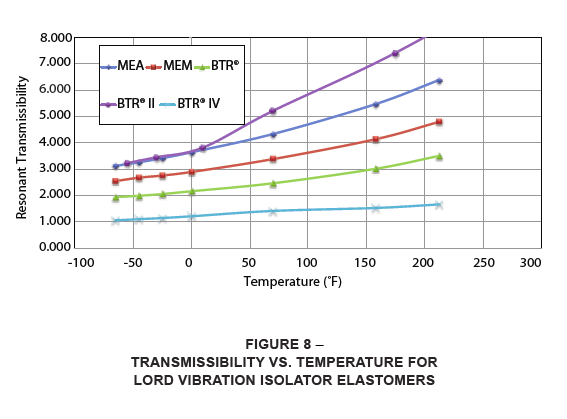
Terms and Definitions
There are a number of terms which should be understood before entering into a discussion of vibration and shock theory. Some of these are quite basic and may be familiar to many of the users of this catalog. However, a common understanding should exist for maximum effectiveness.
Center-of-Gravity System — An equipment installation wherein the center of gravity of the equipment coincides with the elastic center of the isolation system.
Damping — The “mechanism” in an isolation system which dissipates energy. This mechanism controls resonant amplification (transmissibility).
Decibel - (dB) — A dimensionless expression of the ratio of two values of some variable in a vibratory system. For example, in random vibration the ratio of the power spectral density at two frequencies is given as:

Deflection — The movement of some component due to the imposition of a force. In vibratory systems, deflection may be due to static or dynamic forces or to the combination of static and dynamic forces.
Degree-of-Freedom —The expression of the amount of freedom a system has to move within the constraints of its application. Typical vibratory systems may move in six degrees of freedom — three translational and three rotational modes (motion along three mutually perpendicular axes and about those three axes).
Dynamic Matching — The selection of isolators whose dynamic characteristics (stiffness and damping) are very close to each other for use as a set on a given piece of equipment. Such a selection process is recommended for isolators which are to be used on motion sensitive equipment such as guidance systems, radars and optical units.
Dynamic Disturbance — The dynamic forces acting on the body in a vibratory system. These forces may be the results of sinusoidal vibration, random vibration or shock, for example.
Elastomer — A generic term used to include all types of “rubber” — natural or synthetic. Many vibration isolators are manufactured using some type of elastomer. The type depends on the environment in which the isolator is to be used.
Fragility — The amount of vibration or shock that a piece of equipment can take without malfunctioning or breaking. In isolation systems, this is a statement of the amount of dynamic excitation which the isolator can transmit to the isolated equipment.
Free Deflection — The amount of space an isolated unit has in which it can move without interfering with surrounding equipment or structure. This is sometimes called “sway space.”
“g” level — An expression of the vibration or shock acceleration level being imposed on a piece of equipment as a dimensionless factor times the acceleration due to gravity.
Isoelastic — A word meaning that an isolator, or isolation system, exhibits the same stiffness characteristics in all directions.
Isolation — The protection of equipment from vibration and/or shock. The degree (or percentage) of isolation necessary is a function of the fragility of the equipment.
Linear (properties) — A description of the characteristics of an isolation system which assumes that there is no variation with deflection, temperature, vibration level, etc. This is a simplifying assumption which is useful for first approximations, but which must be treated carefully when dealing with critical isolation systems.
Loss Factor — A property of an elastomer which is a measure of the amount of damping in the elastomer. The higher the loss factor, the higher the damping. Loss factor is typically given the Greek symbol “η”. An approximation may be made that loss factor is equal to the inverse of the resonant transmissibility of a vibratory system. The loss factor of an elastomer is sensitive to the loading and ambient conditions being imposed on the system.
Modulus — A property of elastomers (analogous to the same property of metals) which is the ratio of stress to strain in the elastomer at some loading condition. Unlike the modulus of metals, the modulus of elastomers is non-linear over a range of loading and ambient conditions. This fact makes the understanding of elastomers and their properties important in the understanding of the performance of elastomeric vibration and shock isolators.
Natural Frequency — That frequency (expressed in “Hertz” or “cycles per second”) at which a structure, or combination of structures, will oscillate if disturbed by some force (usually dynamic) and allowed to come to rest without any further outside influence. Vibratory systems have a number of natural frequencies depending on the direction of the force and the physical characteristics of the isolated equipment. The relationship of the system natural frequency to the frequency of the vibration or shock determines, in part, the amount of isolation (protection) which may be attained.
Octave — A doubling of frequency. This word is used in various expressions dealing with vibration isolation.
Power Spectral Density — An expression of the level of random vibration being experienced by the equipment to be isolated. The units of power spectral density are “g2/Hz” and the typical symbol is “Sf”.
Random Vibration — Non-cyclic, non-sinusoidal vibration characterized by the excitation of a broad band of frequencies at random levels simultaneously. Typically, many applications of equipment in the field of Military Electronics are exposed to random vibration.
Resilience — The ability of a system to return to its initial position after being exposed to some external loading. More specifically, the ability of an isolator to completely return the energy imposed on it during vibration or shock. Typically, highly damped elastomers have low resilience while low-damped elastomers have good resilience.
Resonance — Another expression for natural frequency. A vibratory system is said to be operating in resonance when the frequency of the disturbance (vibration or shock) is coincident with the system natural frequency.
Resonant Dwell — A test in which the equipment is exposed to a long term vibration at its resonant frequency. This test was used as an accelerated fatigue test for sinusoidal vibration conditions. In recent times, sinusoidal testing is being replaced by random vibration testing and resonant dwell tests are becoming less common.
Returnability — The ability of a system, or isolator, to resume its original position after removal of all outside forces. This term is sometimes used interchangeably with resilience.
Roll-off Rate — The steepness of the transmissibility curve being recorded during a vibration test, after the system natural frequency has been passed. This term is also used to describe the slope of a random vibration curve. The units are typically “dB/octave”.
Symbols
